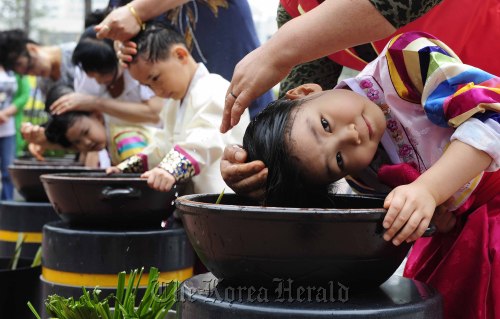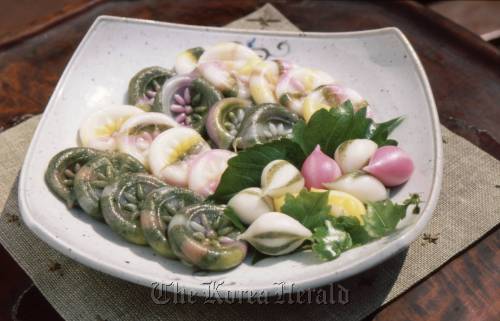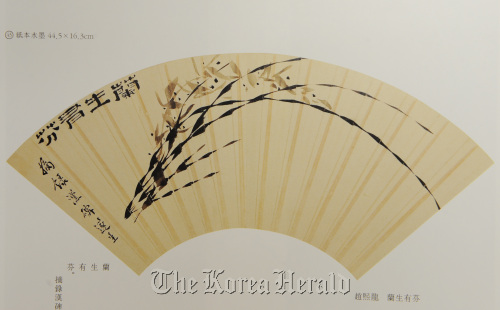Events and rituals celebrate one of the biggest traditional festive days
Summer is kicking in, and the day of the nation’s biggest sun festival is soon approaching.
Dano, one of South Korea’s most important festive days along with Seollal, or Lunar New Year, and Chuseok, or Thanksgiving day, will fall Monday. It comes every fifth day of the fifth month of the lunar calendar, the day of the year on which the “yang,” or the positive energy force, is considered to be at its peak.
Koreans traditionally celebrated the day with various events and rituals such as rinsing one’s hair in “changpomul,” or flag iris water, eating “surichiddeok” which is rice cake enjoyed on Dano, presenting fans decorated with paintings or writings to friends and family, and the usual memorial services for ancestors.
Festivals to enjoy the day as it used to be are already beginning throughout the country.
Summer is kicking in, and the day of the nation’s biggest sun festival is soon approaching.
Dano, one of South Korea’s most important festive days along with Seollal, or Lunar New Year, and Chuseok, or Thanksgiving day, will fall Monday. It comes every fifth day of the fifth month of the lunar calendar, the day of the year on which the “yang,” or the positive energy force, is considered to be at its peak.
Koreans traditionally celebrated the day with various events and rituals such as rinsing one’s hair in “changpomul,” or flag iris water, eating “surichiddeok” which is rice cake enjoyed on Dano, presenting fans decorated with paintings or writings to friends and family, and the usual memorial services for ancestors.
Festivals to enjoy the day as it used to be are already beginning throughout the country.

The largest and the oldest is “Gangneung Danoje Festival” which takes place in Gangneung, Gangwon Province from June 2 through June 9. It was designated as Korean Intangible Cultural Heritage No. 13 in 1967 and as a UNESCO Masterpiece of the Oral and Intangible Heritage of Humanity in 2005.
Preparation for the festival began on May 7, which was the fifth day of April of the lunar calendar and the day for “sinjubitgi,” the distilling of the sacred liquor that is served at memorial services and drunk throughout the events.
The festival will include traditional dances, music and plays including “Gangneung Gwanno Gamyeongeuk,” a traditional mask drama performed by an intangible cultural heritage practitioner group, and “Gangeung Dano Gut,” a shamanic ritual.
This year, the organizers specially invited traditional performance groups from five countries ― Russia, Vietnam, China, Japan and Samoa ― to showcase their traditions as well. The cities of Beijing, China, and Ida, Japan, will also run an Asian Culture Exhibition pavilion during the festival.

The festival will also host many experience programs for visitors to enjoy, providing changpomul for you to rinse your hair and the chance to make surichiddeok. There will also be traditional games like swinging, tug-of-war and “yut,” a traditional board game.
In Seoul, The National Folk Museum of Korea is planning various events in celebration of Dano, particularly to compare how the festive day differs in Korea and China.
Soon after “Gangneung Danoje Festival” was designated as UNESCO Masterpiece of the Oral and Intangible Heritage of Humanity in 2005, a controversy broke out in China that the festival originated in China. China’s festival, named “Duanwu,” was designated by UNESCO four years later.
“Dano and Duanwu are similar in name and period but are actually very different in specific details,” said the museum in a statement.
The museum will hold a photo exhibition from June 1 to June 20, showcasing photos of Korean Dano scenes. On Monday, the museum will hold cooking lessons on how to make surichiddeok and “zongzi,” the Chinese traditional food enjoyed on Duanwu, and showcase Korean traditional performances in the front yard.

Dream Forest in Beon-dong, eastern Seoul, hosts “2011 Dano Gugak Festival” on Saturday, which will showcase a series of Korean traditional music, dance and street plays. Visitors can experience about 30 different kinds of traditional rituals and plays including the traditional Dano fan-making and hair-rinsing.
Similar events will be held at Bukchon Hanok Village in Gye-dong, central Seoul.
For more information on “Gangneung Danoje Festival,” visit www.danojefestival.or.kr; for the events held by The National Folk Museum of Korea, visit www.nfm.go.kr; for “2011 Dano Gugak Festival,” visit www.seoulgugakfestival.org; for events held at Bukchon Hanok Village, visit bukchon.seoul.go.kr.
By Park Min-young (claire@heraldcorp.com)








![[KH Explains] How should Korea adjust its trade defenses against Chinese EVs?](http://res.heraldm.com/phpwas/restmb_idxmake.php?idx=644&simg=/content/image/2024/04/15/20240415050562_0.jpg&u=20240415144419)










![[Today’s K-pop] Stray Kids to return soon: report](http://res.heraldm.com/phpwas/restmb_idxmake.php?idx=642&simg=/content/image/2024/04/16/20240416050713_0.jpg&u=)